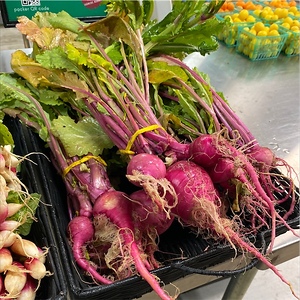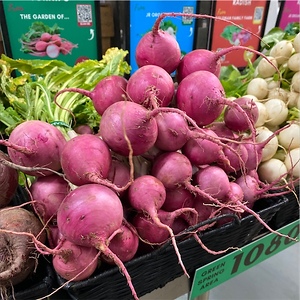


Baby Pink Turnips
Estimated Inventory, bunch : 0
Description/Taste
Baby Pink turnips vary in size and shape, depending on the specific variety, and are generally round to oval with one prominent, tapered taproot. The bulbous roots are connected to thin, upright, and slender stems with broad, frilled, and textured leaves. These stems are often pigmented with red-pink hues, transitioning into dark green leaves. Baby Pink turnip roots have thin, smooth, taut, and firm skin, and depending on the variety, the surface showcases pink, red, magenta, and blush hues. Underneath the surface, the flesh is solid, dense, and aqueous with a crisp, crunchy, and succulent consistency. The flesh is also predominantly white and is sometimes tinged with pink to pale red tones. Select baby turnips that are fresh, feel heavy for their size, and are attached to non-wilted leaves. Baby Pink turnips are entirely edible, including their leaves, stems, and roots, and can be eaten raw or cooked. Raw roots bear a mild, sweet, and delicate peppery taste. Once cooked, their flavor mellows and is enhanced with nutty nuances.
Seasons/Availability
Baby Pink turnips are available year-round, with a peak season in the fall through early summer.
Current Facts
Baby Pink turnips, botanically classified as Brassica rapa, are a category of multiple varieties of small-sized turnips belonging to the Brassicaceae family. Baby root vegetables are favored for their thin skin, delicate flavor, and ease of preparation. It is important to note that the term baby turnip generally encompasses turnips harvested early in their season and varieties that are small in size at maturity. Pink is also a broad descriptor, as some vendors interchangeably use the name pink for both pink and red turnip varieties. Popular varieties of Baby Pink turnips include Japanese, Salad, and Scarlet types. Baby Pink turnips are fast-growing, can be planted in small spaces, and are harvested earlier than other full-grown turnip cultivars. The roots also have a more tender, succulent crunch and mild flavor, allowing them to be used whole in a wide array of fresh or cooked preparations. Baby Pink turnips are considered specialty varieties in present-day markets and are challenging to find compared to their white and purple counterparts. They are also a novelty grown in home gardens for culinary use.
Nutritional Value
Baby Pink turnips vary in vitamin and mineral content, depending on the specific variety, and have not been extensively studied as a standalone group. Turnips, in general, are a source of minerals such as copper, calcium, phosphorus, potassium, and iron. Copper helps the body produce red blood cells, while calcium and phosphorus support the overall health of bones and teeth. Potassium balances fluid levels in the body, and iron develops the protein hemoglobin for oxygen transport through the bloodstream. Turnips also provide other nutrients, including folate, zinc, thiamine, vitamins C and E, magnesium, and manganese. Beyond the roots, turnip greens are a source of vitamins A, C, and K to strengthen the immune system and aid in faster wound healing. They also contain antioxidants to reduce inflammation and improve overall health.
Applications
Baby Pink turnips have a mild, sweet, and nutty flavor suited for fresh and cooked preparations. The tiny root vegetables should be washed before consumption and have thin skin that does not need to be peeled before cooking. One of the defining characteristics of baby turnips is their ability to be eaten raw. The roots and the leaves are edible and can be chopped into salads. Baby Pink turnips are popularly sliced to showcase their colorful nature and served on appetizer platters with creamy dips such as hummus, artichoke spread, and tahini. The roots are also consumed with salt and butter as a snack. Most baby turnips are used in preparations highlighting their small size. Still, they can also be used in any recipe calling for mature turnips, like layering into sandwiches, adding to fresh spring rolls, or mixing into grain bowls. In addition to fresh preparations, Baby Pink turnips are commonly pickled as a tangy condiment. The pickled roots often develop vibrant pink hues and are used as a topping over tacos, rice dishes, grilled meats, and couscous. Baby Pink turnips are also roasted, mashed, braised, grilled, and sauteed. When heated, the roots develop a faint nuttiness and are added to stir-fries, simmered in soups and stews, coated in sweet glazes, or tossed with fresh herbs to accompany other cooked vegetables. In Europe, baby turnips are sometimes cooked with potatoes to make creamy gratins and sides. Beyond the roots, the leaves are edible raw or cooked. Turnip greens add nutrients to soups, noodles, and egg-based dishes or are sauteed as a side. Baby Pink turnips pair well with citrus, other root vegetables, including potatoes, parsnips, carrots, and radishes, and herbs such as dill, cilantro, thyme, and rosemary. Whole, unwashed Baby Pink turnips should be separated from their greens and stored in the refrigerator's crisper drawer for up to one week. The greens should be wrapped in a damp cloth and placed in a container in the fridge for a few days. It is recommended to immediately consume the greens for the best quality and flavor.
Ethnic/Cultural Info
Charles “Turnip” Townshend was an influential English leader in the 18th century who revolutionized crop rotations in agriculture using turnips. Townshend had a passion for agriculture throughout his life, and when he inherited his family’s estate in Raynham, Norfolk, in 1702, he began conducting agricultural experiments on the available farmland on his property. Townshend was well-traveled and learned of a new system of crop rotation in the Netherlands where four cycles were made instead of two. Historically, English growers would replenish nutrients into the soil by leaving fields barren, a system called fallowing. Townshend instead adopted a method where he integrated turnips and clovers into the crop cycle, increasing productivity while putting nutrients back into the soil. Turnips were a crucial crop to this system as they helped restore soil nutrients and acted as food for livestock, allowing farmers to keep their livestock alive during the winter months. This led to a boost in natural fertilizer availability through the livestock’s excrement, which also, in turn, helped nurture the soil. Townshend was an advocate for turnips and even acquired the nickname of turnip at one point in his career, becoming Charles “Turnip” Townshend. The four-crop rotation was officially called the Norfolk four-course system throughout England, and though it was initially slow to catch on, the efforts made by Charles Townshend helped to establish the system as the primary method of crop cultivation. The Norfolk four-course system also led to the beginning of the British Agricultural Revolution, which overlapped with the British Industrial Revolution.
Geography/History
Turnips are believed to be native to regions of Central Asia, and wild forms of Brassica rapa are seen to have the most diversity in the Hindu Kush Mountains, a mountain range spanning parts of Afghanistan, Pakistan, and Tajikistan. Brassica rapa was later spread to Europe and East Asia, and over time, the species was cultivated for specific characteristics, developing varying forms. The exact origins of Baby Pink turnips are unknown, but baby turnips, in general, have been cultivated throughout history as an early-harvested root crop. The term baby turnip was officially used in commercial markets around the 19th century, and baby vegetables appeared on shelves during the 1870s. In Japan, new small-sized varieties called salad turnips were developed and commercially released after World War II to encourage the cultivation of turnips in home gardens. Other countries also developed their own salad turnips and baby turnip cultivars over time. Baby turnips gained worldwide recognition in the 1960s with the emergence of La Nouvelle cuisine in France. They were also used in California cuisine in the late 20th century through farm-to-table restaurants in the United States, and major retailers began offering baby vegetables in their fresh produce sections. Today, Baby Pink turnips are grown commercially on a small scale and planted in home gardens in temperate regions worldwide. The fleshy roots and greens are sold through local farmer’s markets in their growing areas and are offered through select retailers and wholesalers.
Recipe Ideas
Recipes that include Baby Pink Turnips. One

















